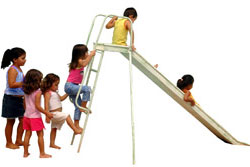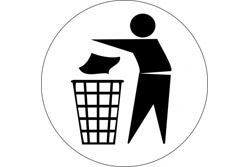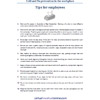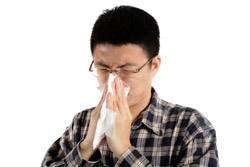- Cold and flu prevention
- How do cold and flu spread?
- Stopping the spread of cold and flu viruses at work
- Measures to keep infected individuals out of the workplace
- Measures to reduce employees’ risk of infection
- Workplace hygiene measures to prevent cold and flu transmission
- Printable workplace poster on preventing cold and flu
Cold and flu prevention
Cold and flu spread more easily in the cold winter months because they thrive in colder, less humid environments. More people become infected with colds and flus in winter. In Australia, cold and flu infections are most likely to occur between May and September. At this time you have a higher risk of contracting colds and flus at work, because it is more likely your colleagues will catch colds and flus which they can pass on at work. That means you’re more likely to need time off work in winter to recover from a cold or flu, and this may interfere with work deadlines and your productivity at work.
Whether you work in an office, healthcare facility or other workplace, you are at risk of contracting a virus at work, from your colleagues or people who visit your workplace (e.g. patient if you work in a health facility or children if you are a childcare worker). While cold and flu viruses spread rapidly in indoor environments like offices, they can also spread in outdoor work environments, when they become airborne or contaminate a surface that many people touch, like the handle of a tool.
How do cold and flu spread?
Cold and flu viruses are highly contagious and the contagious period begins immediately after infection. In the early stage of infection, a person with a cold or flu does not have symptoms like blocked nose or coughing. Thus they are unaware that they are sick and may infect others unknowingly. Influenza is typically contagious for 24 hours before symptoms appear, and continues to be contagious for up to seven days. Common colds are typically most contagious for the initial 2–3 days of infection but may be passed on to others up to a week later.
People who go to work while they are infected with cold and flu may expose their colleagues and workplace visitors to their virus, for example if they cough or sneeze at work.
Colds and flu cause employees to take more time off work overall and reduce their productivity when they go to work but are unwell. Because it is not always possible to identify people who have a cold or flu and/or keep them away from the workplace, effective cold and flu prevention at work requires more than simply avoiding those known to be infected.
Stopping the spread of cold and flu viruses at work

Respiratory droplets containing cold and flu viruses may also settle on surfaces in the vicinity of the infected person (within one metre of them). Other people who touch these surfaces may contaminate their hands and then infect themselves if they touch their face. People might also become infected by shaking hands or making other contact with infected individuals who have coughed or sneezed onto their hands. Employers should take measures to ensure staff who know they have a cold or flu stay away from work until their symptoms resolve and they are no longer contagious.
If no one with a cold or flu entered the workplace during the contagious period of infection, transmission at work would be avoided. However, in the initial period of cold or flu infection when there are no symptoms, individuals are contagious but unaware of their infection.
The nature of some workplaces, for example healthcare settings, means that some employees are unable to avoid other individuals even if they know they have a cold or flu infection. Implementing good hygiene and flu vaccination policies in the workplace are therefore necessary to minimise the spread of cold and flu.
Get on top of your general health
Find and instantly book affordable GPs within Australia
Measures to keep infected individuals out of the workplace
Stay away from work if you have cold and flu
Staying at home when you are ill is an important measure to reduce the likelihood you will share your cold or flu virus with a colleague. Even when you are not feeling so ill that you need to rest and recuperate, you may still be contagious and should stay at home. This will reduce the likelihood that your cold or flu virus will enter the workplace and infect others. You should also go home immediately if you feel yourself coming down with a cold or flu while you are at work.
 |
For more information on recognising the symptoms of colds and flu, see Cold and Flu: Which Do I Have? |
In some workplaces, staff may be screened for influenza and instructed to go home if they are infected. Screening is most likely to occur in workplaces where staff are in close contact with people who have a high risk of flu complications, such as in hospital intensive care units.
Equip the workplace for cold and flu prevention
Workplaces should be equipped with a range of hygiene products that can be used to prevent transmission of cold and flu. These include tissues, soap, paper towels and disinfectant gels and wipes. Talk to your employer about providing these products if they do not already.
Be prepared to take time off when cold or flu hit
To ensure you are able to take time off work when you have cold or flu, it is important to make plans to ensure your job (or at least the most vital components of it) gets done while you are away. Try to train at least one other person to do your job so they can cover for you in periods of illness. If you work in an office, talk to your employers about providing facilities that allow you to work from home when you are contagious but not feeling sick enough for time off work, such as remote meeting and teleconferencing facilities.
Keep visitors with cold and flu away from workplaces

Cold and flu signs and reminders
Putting up signs to remind staff and visitors to stay away when infected and practise good hygiene to prevent spreading infections at work can also help prevent cold and flu spreading. Signs should be placed strategically around the workplace (e.g. at entrances, in lifts and stairwells). Signs may ask infected staff or visitors to:
- Inform someone of their illness before entering the workplace;
- Perform hygiene practices such washing hands when they enter the workplace;
- Use personal protective equipment such as a surgical mask while in the workplace.
These measures are regulation for healthcare facilities but may also be of use in other workplaces.
Measures to reduce employees’ risk of infection
Cold and flu information and education
Being informed about cold and flu is an important workplace strategy for reducing transmission. Training programs may include information about how influenza is transmitted and how transmission can be prevented. Ask your employer to hold an information day or provide factsheets about cold and flu in the workplace. If you work with people who speak languages other than English, it may be a good idea to provide written information about influenza in multiple languages.
Influenza vaccination

- Aged over 65;
- Who are pregnant;
- Who are over 6 months of age and have medical conditions which increase the risk of severe infection and complications if they do catch the flu, including:
- Whose jobs make it highly likely that they will be in contact with infected individuals (e.g. health and childcare workers, plumbers).
Influenza vaccination reduces the likelihood of flu even for healthy adults. It is important to get a flu shot every year, as the vaccines are updated annually to include the most recent influenza strains.
To ensure the vaccine has enough time to stimulate antibody production before flu season, make sure you are vaccinated during autumn. Workplace vaccination is mandatory and paid for by employers of people who work in some industries (e.g. for healthcare workers in direct contact with patients or infected body fluids). In other industries it is voluntary, although employers may fund workplace vaccination programs because they maximise the number of employees who get immunised and minimise absenteeism due to influenza infection. Employers may also help their staff get vaccinated by making it easier to get the flu shot. For example they may provide transport to the clinic or organise a mobile clinic to visit the worksite.
 |
For more information on influenza vaccination, see Flu Vaccine. |
Preventing cold and flu with protective equipment
The use of personal protective equipment such as facemasks may be warranted if your job makes you highly likely to come into contact with infected individuals (e.g. work in a hospital). Visitors may also wear protective equipment to protect themselves or prevent passing their infection to others. For example, patients who are coughing when they arrive at a clinic may be asked to wear a surgical mask.
Staying healthy to fight cold and flu infection
Staying healthy reduces the risk of infections like cold and flu. Make sure you:
- Maintain a healthy diet;
- Exercise regularly but avoid very strenuous exercise;
- Avoid stress;
- Get plenty of sleep;
- Quit smoking;
- Stay properly hydrated by drinking plenty of fluids;
- Drink alcohol in moderation.
Workplace hygiene measures to prevent cold and flu transmission
Hand washing

- After coughing, sneezing or blowing your nose;
- Before touching your face;
- After touching contaminated objects such as tissues;
- After cleaning surfaces which may be contaminated;
- After shaking hands with someone known or suspected to be infected.
Covering mouths and noses when sneezing or coughing
Practising good cough and sneeze etiquette – covering the mouth and nose when sneezing or coughing – reduces the likelihood of cold and flu viruses becoming airborne and/or contaminating surfaces and other objects in the work environment. However, when the hands are used to cover the mouth, they become contaminated. Use a tissue to cover your mouth and nose if you cough or sneeze and encourage your workmates to do the same. The tissue should be disposed of and the hands washed immediately afterwards. If no tissue is available, cough into the sleeve at the inner elbow. Make sure you have a bin for tissue disposal. Ask your boss to place signs around the workplace to remind people to practise good cough etiquette.
Avoid touching mouths, noses and eyes
Cold and flu viruses can survive on hard surfaces for up to eight hours and on a person’s hands for approximately five minutes after they touch a contaminated surface such as a hand or desktop. From there they can cause infection if the person touches their mouth or eyes. You can therefore reduce your risk of infection by avoiding touching your face, or washing your hands before you do so.
Clean surfaces and equipment
Shared surfaces and equipment in the workplace should be cleaned regularly to ensure cold and flu viruses are removed. Ideally they should be wiped with disposable disinfectant wipes. Surfaces and objects that should be cleaned regularly include:
- Door knobs and handles;
- Buttons on equipment such as photocopiers or microwaves;
- Surfaces of shared equipment such as power tools;
- Keyboards, particularly before you use another person’s keyboard;
- Telephone buttons and handles, particularly before you use another person’s telephone;
- Handles of kitchen equipment like coffee pots and microwaves;
- Benches and counters;
- Books or other materials which are shared.
Dispose of articles contaminated with cold and flu germs

- Tissues;
- Disposable wipes used for cleaning surface;
- Clothes or products used to clean an infected person;
- Articles which have been in contact with an infected person such as bedding or clothing.
Keep a distance from people with cold and flu
In the workplace, avoid close contact with people who are known or suspected to be ill. Whenever possible:
- Stand at least one metre away from people with infections;
- Avoid skin contact (e.g. shaking hands), with infected individuals;
- Wash your hands as soon as possible after skin contact with an infected individual occurs;
- Avoid sharing eating and drinking utensils like straws and spoons.
Workplace hygiene reminders
Reminders for staff and visitors to implement hygiene measures to prevent cold and flu transmission may help improve hygiene behaviour. For example, you could ask your employer to place reminders:
- To wash hands, in toilets (after going to the toilet) or in kitchens (before eating);
- To cover the mouth and nose when coughing or sneezing, in prominent locations around the workplace;
- To stay home when sick, in prominent locations throughout the workplace;
- Clean surfaces in their work environment, for example wipe the desk and keyboard.
Printable workplace poster on preventing cold and flu
 |
Download a printable workplace poster on preventing cold and flu for employees and for employers. |
More information
 |
For more information on the common cold and influenza, types of influenza and treatments and tips for preventing influenza, see Cold and Flu. |
References
- Common cold [online]. Bethesda, MD: National Institute of Allergy and Infectious Disease; 20 May 2011 [cited 3 May 2013]. Available from: [URL link]
- Covington TR, Henkin R, Miller S, et al. Treating the common cold: An expert panel consensus recommendation for primary care clinicians [online]. Lisle, IL: Illinois Academy of Family Physicians; October 2004 [cited 6 June 2011]. Available from: [URL link]
- Influenza – Minimising transmission of influenza in healthcare facilities: 2010 influenza season [online]. North Sydney, NSW: NSW Health; 22 June 2010 [cited 22 April 2013]. Available from: [URL link]
- Common cold [online]. Bethesda, MD: MedlinePlus; 8 January 2012 [cited 22 April 2013]. Available from: [URL link]
- Preventing the flu in 2011-2012: Strategies and resources for child care providers and out-of-home caregivers of children [online]. Washington, DC: American Academy of Pediatrics; 2011 [cited 22 April 2013]. Available from: [URL link]
- Prevention tips to limit the spread of colds and flu [online]. University of Melbourne; 11 April 2013 [cited 18 April 2013]. Available from: [URL link]
- Tips to prevent cold and flu in the workplace [online]. Boston, MA: Simmons College; 2007 [cited 9 June 2013]. Available from: [URL link]
- Seasonal flu: Good health habits can stop germs [online]. Atlanta, GA: Centers for Disease Control; 11 January 2013 [cited 9 June 2013]. Available from: [URL link]
- Olszewska W, Zambon M, Openshaw PJ. Development of vaccines against common colds. Br Med Bull. 2002;62(1):99-111. [Abstract | Full text]
- 2013 seasonal influenza vaccines [online]. Woden, ACT: Therapeutic Goods Administration; 28 February 2013 [cited 3 May 2013]. Available from: [URL link]
- Immunisation for health care workers [online]. Melbourne, VIC: Department of Health Victoria; October 2007 [cited 22 April 2013]. Available from: [URL link]
- About influenza [online]. Melbourne, VIC: Influenza Specialist Group; 2013 [cited 9 June 2013]. Available from: [URL link]
- How influenza is spread [online]. Melbourne, VIC: Influenza Specialist Group; 2013 [cited 9 June 2013]. Available from: [URL link]
- Nonpharmaceutical interventions and CDC’s Community Interventions for Infection Control Unit [online]. Atlanta, GA: Centers for Disease Control and Prevention; 5 August 2012 [cited 9 June 2013]. Available from: [URL link]
- Questions and answers for influenza (flu) vaccination 2013 [online]. Canberra, ACT: Australian Government Department of Health and Ageing; 19 March 2013 [cited 9 June 2013]. Available from: [URL link]
- Workplace immunisation [online]. Melbourne, VIC: Department of Health Victoria; 19 February 2013 [cited 9 June 2013]. Available from: [URL link]
- Tips for providing a workplace influenza vaccination program [online]. Melbourne, VIC: Department of Health Victoria; 2012 [cited 9 June 2013]. Available from: [URL link]
- Everyday prevention actions that can help fight germs, like flu [online]. Atlanta, GA: Centers for Disease Control and Prevention; 21 May 2013 [cited 9 June 2013]. Available from: [URL link]
All content and media on the HealthEngine Blog is created and published online for informational purposes only. It is not intended to be a substitute for professional medical advice and should not be relied on as health or personal advice. Always seek the guidance of your doctor or other qualified health professional with any questions you may have regarding your health or a medical condition. Never disregard the advice of a medical professional, or delay in seeking it because of something you have read on this Website. If you think you may have a medical emergency, call your doctor, go to the nearest hospital emergency department, or call the emergency services immediately.








